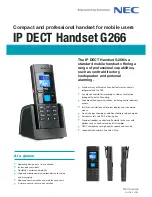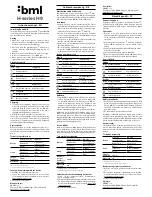
3
from any connected external device such as 2-way radios and phones may exceed
safe levels and must be appropriately limited by the user. Always use external devices
at the lowest sound level possible for the situation and limit the amount of time you are
exposed to unsafe levels as determined by your employer and applicable regulations.
If your hearing seems dulled or you hear a ringing or buzzing during or after any sound
exposure, or for any other reason you suspect a hearing problem, go to a quiet
environment immediately and consult a medical professional and/or your supervisor.
i. If the requirements above are not adhered to, the protection afforded by the earmuffs
will be severely impaired.
n
CAUTION:
• Risk of explosion if battery is replaced by an incorrect type.
•
$OZD\VXVHSURGXFWVSHFL¿F0UHSODFHPHQWSDUWV8VHRIXQDXWKRUL]HGUHSODFHPHQWSDUWV
may reduce the protection you receive from this product.
NOTE:
• When worn according to the User Instructions, this hearing protector helps reduce exposure to
both
continuous
noises, such as industrial noises and noises from vehicles and aircraft, as well
as very loud
impulse
noises, such as gunfire. It is difficult to predict the required and/or actual
hearing protection obtained during exposure to impulse noises. For gunfire, the weapon type,
number of rounds fired, proper selection, fit and use of hearing protection, proper care of
hearing protection, and other variables will impact performance. To learn more about hearing
protection for impulse noise, visit www.3M.com/hearing.
• This earmuff is provided with electrical audio input. The wearer should check correct operation
before use. If distortion or failure is detected, the wearer should refer to the manufacturer’s
advice.
• In Canada, users of hard hats combined with earmuffs must refer to CSA Standard Z94.1 on
industrial protective headwear.
• When selecting accessories to respiratory personal protective equipment, such as hard hat
PRXQWHGKHDULQJSURWHFWLRQSOHDVHFRQVXOWWKH1,26+DSSURYDOODEHORUFRQVXOW07HFKQLFDO
Services for approved configurations.
2SHUDWLQJWHPSHUDWXUHUDQJH)&WR)&
6WRUDJHWHPSHUDWXUHUDQJH)&WR)&
U.S. EPA Required Statements
,PSURSHU¿WRIWKLVGHYLFHZLOOUHGXFHLWVHIIHFWLYHQHVVLQDWWHQXDWLQJQRLVH&RQVXOWWKHHQFORVHG
LQVWUXFWLRQVIRUSURSHU¿W
Although hearing protectors can be recommended for protection against the harmful effects of
LPSXOVLYHQRLVHWKH1RLVH5HGXFWLRQ5DWLQJ155LVEDVHGRQWKHDWWHQXDWLRQRI
continuous
noise and may not be an accurate indicator of the protection attainable against
impulsive
noise
VXFKDVJXQ¿UH
The level of noise entering a person's ear, when the hearing protector is worn as directed, is
closely approximated by the difference between the A-weighted environmental noise level and
WKH155
Example:
1. The environmental noise level as measured at the ear is 92 dB(A).
7KH155LVGHFLEHOVG%
3. The level of noise entering the ear is approximately equal to 72 dB(A).
n
Caution:
)RUQRLVHHQYLURQPHQWVGRPLQDWHGE\IUHTXHQFL]WKH&ZHLJKWHG
environmental noise level should be used.
Rendered on 1/23/2020 10:54:14 AM
Page 3
34-8725-1903-7 ComTac V manual.pdf




































